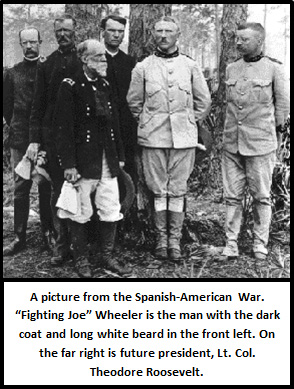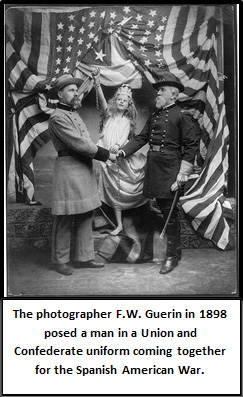
Source: Theodore Roosevelt and Officers, Wikimedia

Source: Theodore Roosevelt and Officers, Wikimedia
In 1898, the United States declared war on Spain. President William McKinley appointed an aging old Confederate cavalry officer, "Fighting Joe" Wheeler, to serve as major general of the American army. In the heat of battle, the elderly Wheeler confused the two wars. He reportedly shouted, "Let's go boys! We've got the Yankees on the run again!" and "Let's get those Yankees, I mean Spaniards!"
Regardless of his military ability, McKinley chose Wheeler partly to symbolize that after decades of sectional divide, the country had healed. North and South were one nation again. Reconstruction worked. And the truly "United" States was about to pummel the Spanish in a two-month "splendid little war."

Source: Cuba Libre, Library of Congress
The picture of a former Confederate symbolizing the success of Reconstruction was perhaps fitting. In many ways, the country had unified largely on Southern terms. While the 13th, 14th, and 15th amendments to the Constitution ended slavery, gave freedmen citizenship, and guaranteed voting rights, these provisions were largely ignored by the new "redeemed" state governments.
By 1900, only 5% of the African-American population in the South was able to vote. The plantation, agricultural based "way of life" that the South fought so hard to keep in the Civil War endured, with slaves replaced by sharecroppers.
How did this happen? In 1866, Northern voters were so angry at the actions of the South that they swept into office the Radical Republicans. They promptly passed the Reconstruction Act of 1867 that sent troops to govern most of the former Confederacy. By 1877, the troops had left and white governments had recaptured almost all Southern states.
This lesson will examine the reasons for the end of Reconstruction. Before we can analyze the reasons, we need to understand just how to explain a complicated historical event. For that, we'll need a little E-S-P.